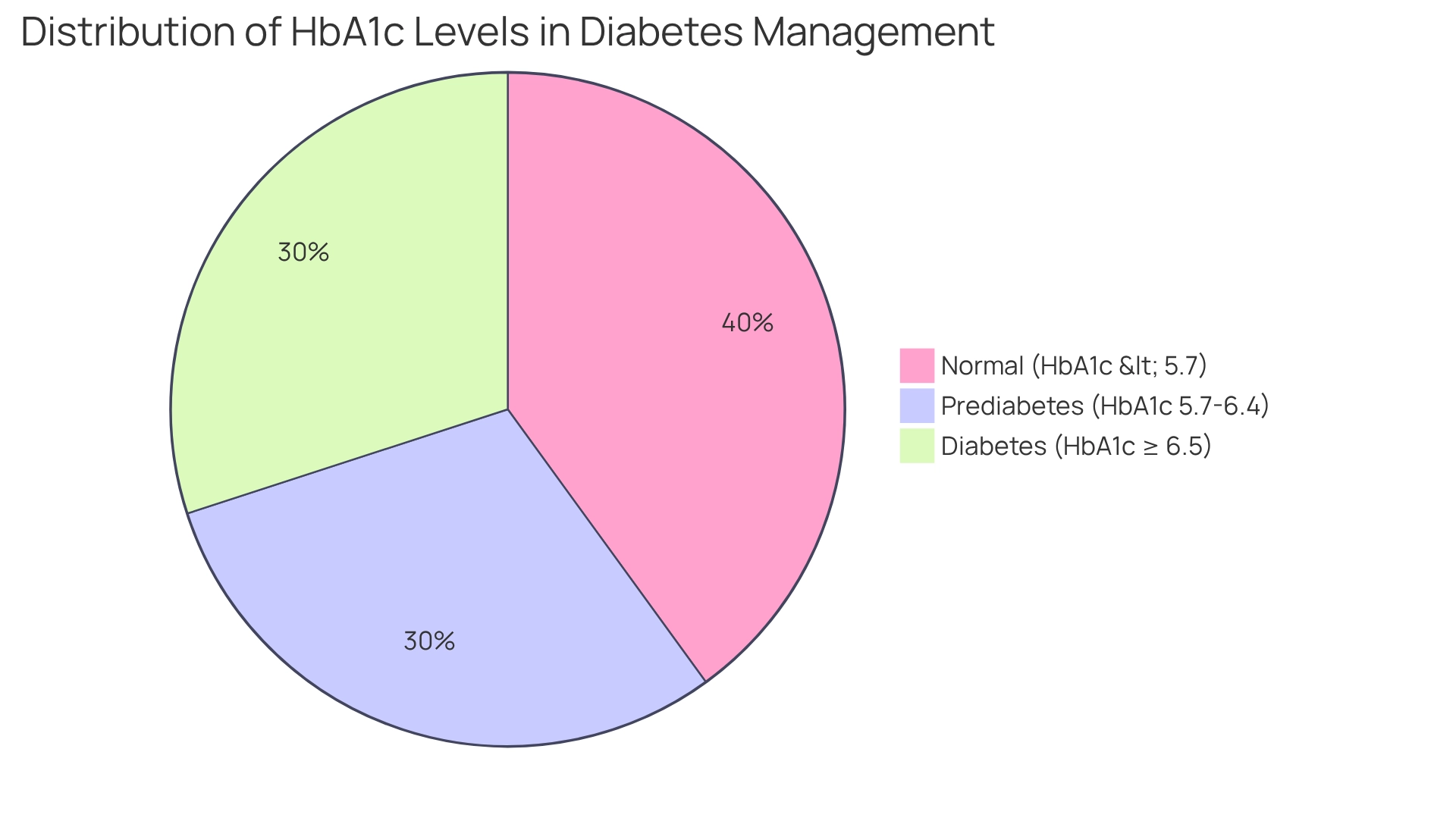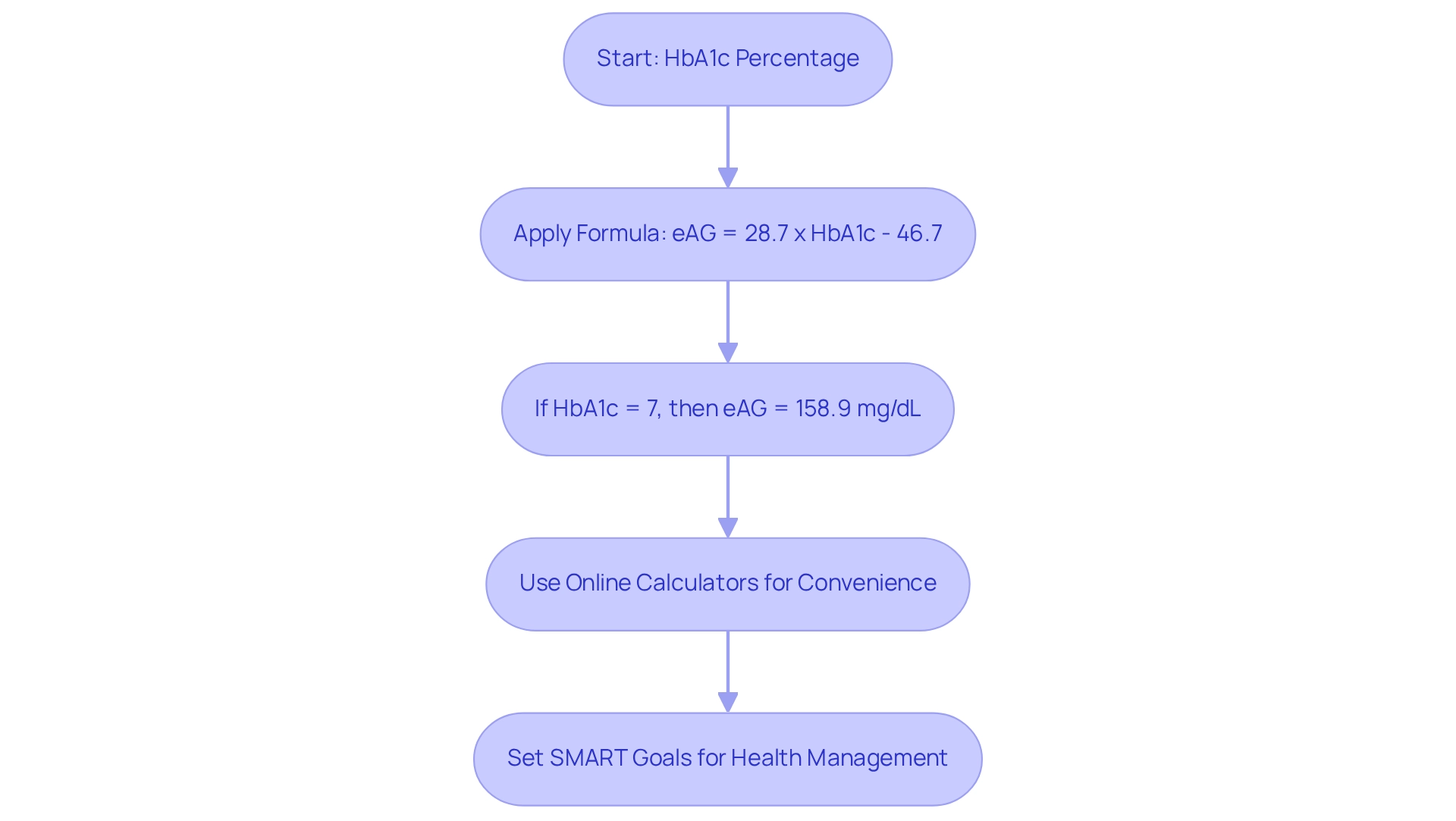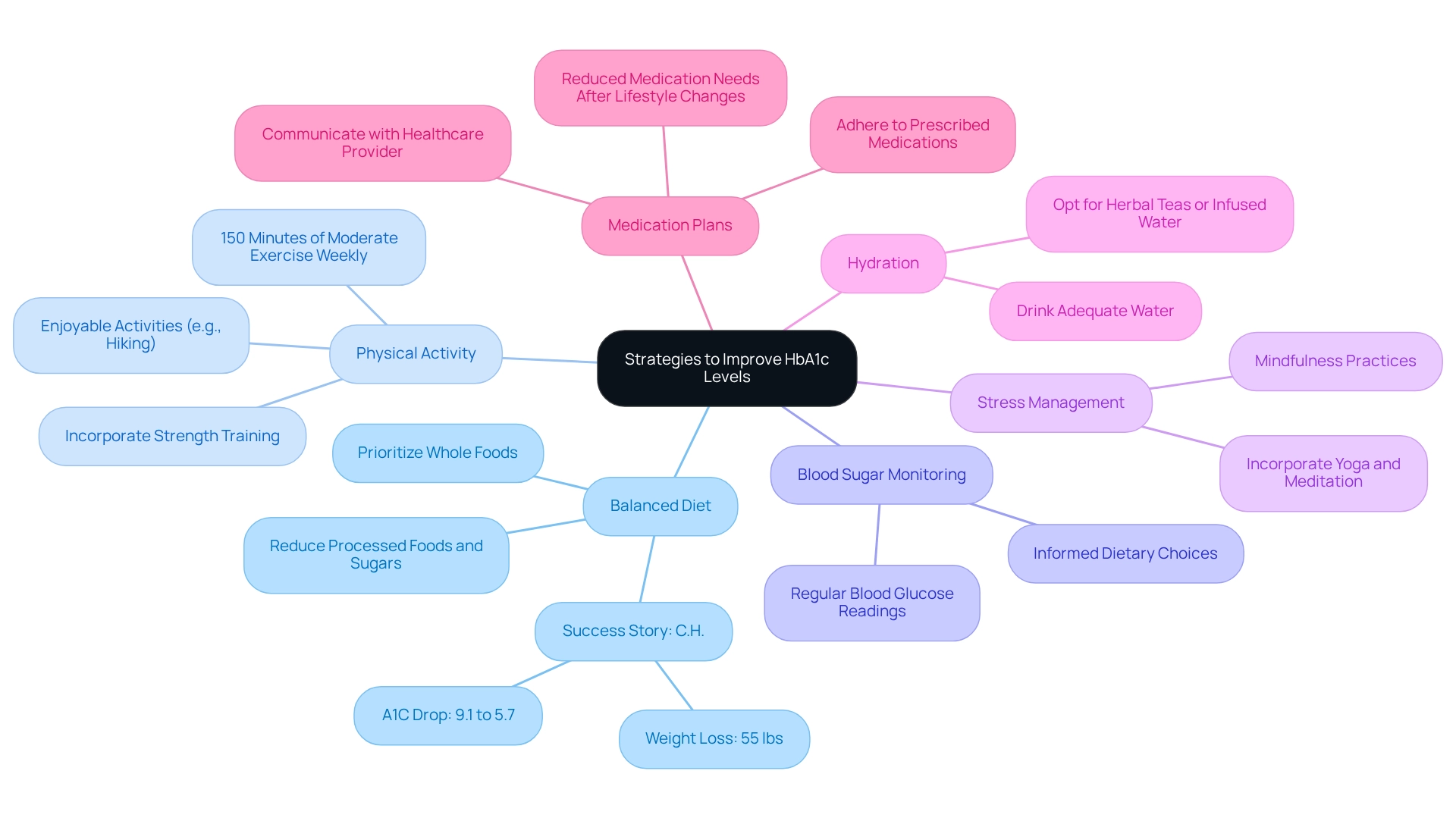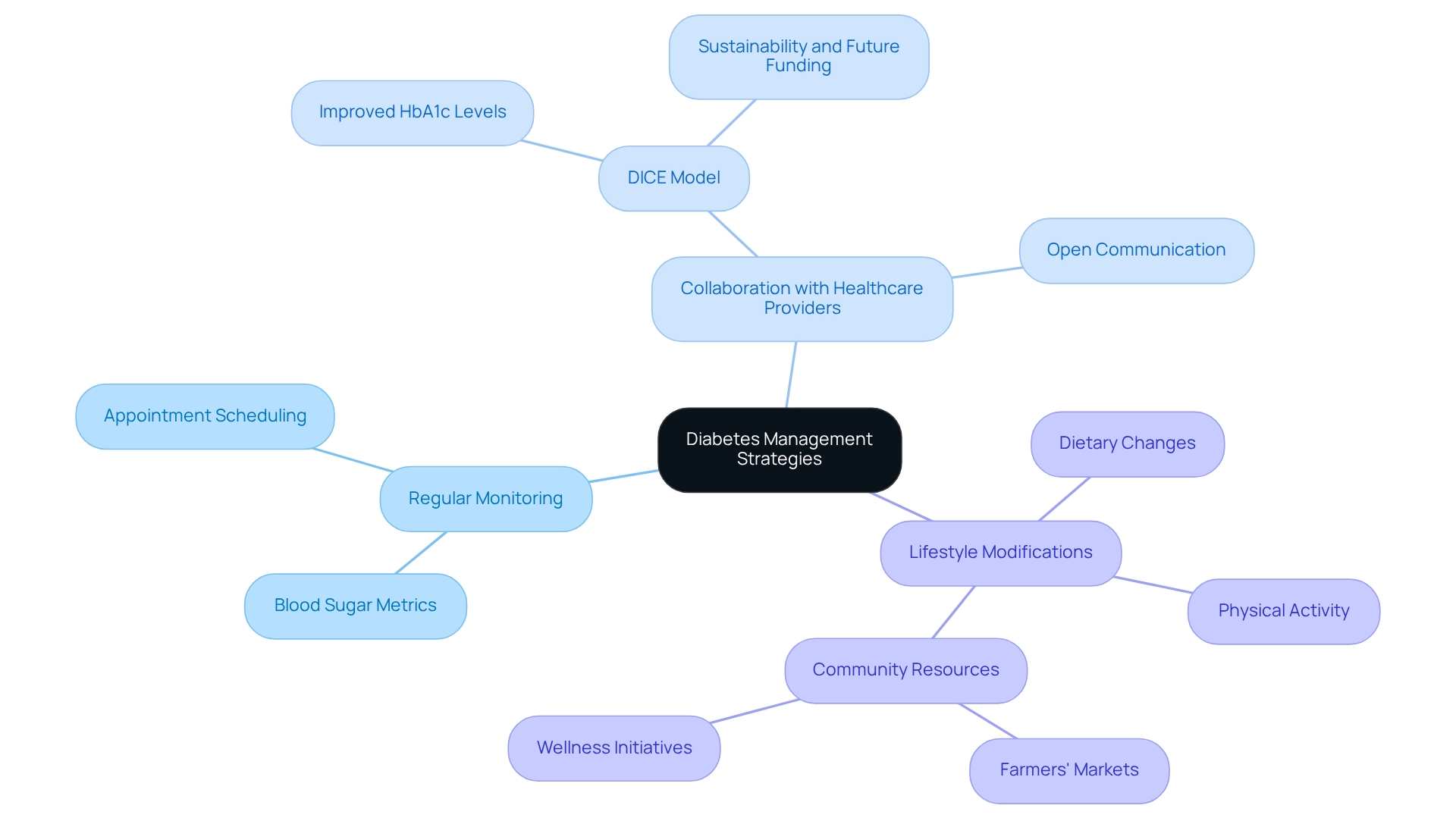Overview
This article addresses the essential steps for transforming diabetes management, particularly through effective HbA1c conversion and monitoring strategies. It’s important to recognize that understanding HbA1c levels is crucial, as they reflect average blood glucose levels. Many patients find that adopting a balanced diet, increasing physical activity, and collaborating with healthcare providers can significantly improve these levels and enhance overall health outcomes.
Have you ever felt overwhelmed by managing your diabetes? You’re not alone. Many individuals share similar struggles, and it’s vital to approach these challenges with compassion and understanding. By taking actionable steps, you can make a positive impact on your health.
Consider this: a balanced diet doesn’t have to be restrictive; it can be enjoyable and fulfilling. Incorporating more fruits, vegetables, and whole grains can help stabilize your blood sugar levels. Additionally, increasing your physical activity, even through simple activities like walking or dancing, can lead to remarkable improvements.
Remember, you don’t have to navigate this journey alone. Collaborating with healthcare providers can provide you with the support and guidance you need. Together, you can create a personalized plan that works for you.
As you embark on this journey, keep in mind the 30-Day Diabetes Reset program. It’s designed to empower you with knowledge and strategies to take control of your health. You have the strength to make these changes, and every small step counts.
In closing, remember that managing diabetes is a journey filled with ups and downs. With the right support and strategies, you can achieve better health and well-being. You are capable of making these changes, and we are here to support you every step of the way.
Introduction
In the intricate landscape of diabetes management, understanding HbA1c levels is crucial for achieving optimal health outcomes. This vital blood test not only reflects average blood glucose levels over the preceding months but also serves as a barometer for individuals navigating the complexities of diabetes. It’s important to recognize that many patients face challenges in maintaining these levels within recommended ranges. With this in mind, we will explore practical approaches that empower you to take charge of your health.
From dietary adjustments to collaborative care models, the insights shared in this article highlight the significance of proactive management. Many patients find that small changes can lead to significant improvements in their well-being. As you embark on your journey toward better diabetes control, remember that informed decision-making and consistent monitoring are key. Together, we can navigate this path and reduce the risk of complications, enhancing your overall quality of life.
Understand HbA1c: Definition and Importance in Diabetes Management
Glycated hemoglobin is an essential blood test that reflects your average blood glucose readings over the previous two to three months, expressed as a percentage. It’s important to recognize that elevated percentages indicate poorer blood sugar regulation, making it crucial for those with diabetes to monitor these measurements closely. Aim to keep your blood sugar levels under 7% (53 mmol/mol) to reduce the likelihood of complications associated with this condition.
Understanding your blood sugar averages is vital for evaluating the success of your health care strategy. Regular testing not only provides insights into your overall glycemic control but also helps identify trends that may require adjustments in your treatment plan. Many patients find that lifestyle changes, such as consistent exercise and a nutritious diet rich in local produce, can significantly improve their ability to maintain ideal glucose levels, especially in places like San Marcos, CA, which is crucial for successful HbA1c conversion, as current statistics reveal that a considerable number of individuals with type 2 diabetes struggle to keep their HbA1c values within the recommended range.
The statistical significance of these findings, indicated by p-values less than 0.0001, underscores the importance of effective management strategies, especially regarding HbA1c conversion. Case studies, such as ‘Understanding A1C Results,’ illustrate how clear classification of A1C readings aids healthcare professionals in confirming diagnoses and tailoring treatment plans. These results categorize individuals into normal, prediabetes, or diabetes based on specific percentage thresholds, guiding further testing and treatment. For example, those with consistently high blood sugar levels often face various complications, highlighting the importance of proactive care. Recent studies further emphasize that maintaining blood glucose readings below 7% is associated with an enhanced quality of life and reduced reliance on traditional medical treatments.
Experts in the field stress the critical role of blood glucose levels in diabetes management. Endocrinologists emphasize that consistent monitoring and understanding of blood sugar readings empower patients to take charge of their health, leading to improved outcomes. By offering actionable insights and practical tools, healthcare providers, including Dr. Jason Shumard, can create an environment where individuals reclaim their well-being through personalized functional medicine approaches, ultimately enhancing their quality of life.
Additionally, engaging with local farmers’ markets can provide access to fresh, seasonal produce that supports a diabetes-friendly diet. Staying hydrated with water or herbal teas can further assist in blood sugar regulation. Incorporating stress management techniques, such as yoga or meditation, can also play a vital role in maintaining overall health and well-being.
Convert HbA1c Results to Average Blood Glucose Levels
Transforming your percentage of HbA1c to estimated average glucose (eAG) values via HbA1c conversion can feel daunting, but it’s simpler than you might think. You can apply the formula:
eAG (mg/dL) = 28.7 x your percentage - 46.7
For instance, if your HbA1c is 7%, the calculation would be:
eAG = 28.7 x 7 - 46.7 = 158.9 mg/dL
This HbA1c conversion helps you comprehend your average blood glucose readings over the past few months, creating a meaningful connection to your daily monitoring. Many patients find that using online calculators makes this HbA1c conversion even easier. These tools provide a quick and user-friendly way to interpret your results, which can be incredibly helpful.
It’s important to recognize that improving your health is a journey, and setting SMART goals—specific, measurable, attainable, relevant, and time-bound—related to your blood glucose levels can make a significant difference. For example, you might aim to lower your blood sugar levels by a certain percentage within a specific timeframe.
Regularly tracking your progress not only fosters accountability but also allows you to adapt your goals as needed, ensuring they remain appropriately challenging. Additionally, participating in community wellness initiatives and focusing on a balanced diet rich in local produce can enhance your overall health and management efforts. Remember, you’re not alone on this journey, and every step you take is a step toward better health.
Implement Strategies to Improve Your HbA1c Levels
To effectively improve your HbA1c levels, consider implementing the following strategies:
-
Adopt a Balanced Diet: Prioritize whole foods, including a variety of vegetables, lean proteins, and whole grains. Reducing processed foods and sugars can significantly impact your blood sugar control. Many individuals, like C.H., have experienced remarkable improvements in their health by embracing a balanced diet. After participating in Dr. Jason Shumard’s 30-Day Diabetes Reset program, C.H. lost 55 lbs and saw their A1C drop from 9.1 to 5.7, demonstrating the power of dietary changes.
-
Increase Physical Activity: Aim for a minimum of 150 minutes of moderate aerobic exercise each week, complemented by strength training. It’s important to recognize that regular physical exercise is essential for glycemic regulation in individuals with type 2. Participating in outdoor pursuits, like hiking or strolling in the lovely parks of San Marcos, can make exercise enjoyable and sustainable, further aiding your health journey.
-
Monitor Blood Sugar Regularly: Keeping a close eye on your blood glucose readings helps you understand how different foods and activities influence your results, allowing for more informed dietary choices. Consistent observation can enable you to implement changes that positively influence your HbA1c conversion results, similar to the individuals who have effectively managed their diabetes with tailored support from Dr. Shumard.
-
Manage Stress: Many patients find that incorporating stress-reduction techniques such as yoga, meditation, or deep-breathing exercises into their routine is crucial. Managing stress can directly influence blood sugar rates. Engaging in mindfulness practices not only improves mental well-being but also supports better blood sugar control.
-
Stay Hydrated: Drinking adequate water throughout the day supports optimal blood sugar levels and overall health. Hydration is crucial for sustaining bodily functions and can assist in improved glucose regulation. Consider opting for herbal teas or infused water to enhance your hydration routine.
-
Follow Medication Plans: Adhere to prescribed medications and maintain open communication with your healthcare provider regarding any concerns or side effects. Adhering to your medication plan is essential for effective control of blood sugar levels. Patients like C.H. have observed their medication requirements diminish considerably after implementing lifestyle modifications under Dr. Shumard’s supervision.
By embracing these techniques, you can make considerable progress toward enhancing your blood sugar control and overall health. Success stories from individuals who have embraced regular physical activity and dietary changes highlight the positive impact these adjustments can have on health outcomes. As Frank Zappa wisely noted, an open mind is essential for personal growth and health improvement—embrace these changes with a positive outlook.
Monitor Your Progress and Collaborate with Healthcare Providers
Regular oversight of your blood sugar metrics, along with cooperation with your healthcare team, is crucial for effective diabetes management. It’s important to recognize that increased insulin amounts can lead to significant health issues, such as different forms of cancer, weight gain, and heart disease. Tackling these concerns proactively is essential.
- Schedule regular appointments to review your progress and address any challenges you may encounter.
- During these consultations, present your blood glucose logs and discuss any lifestyle modifications you’ve made, such as dietary changes and increased physical activity.
These adjustments are vital for improving insulin sensitivity and overall health, with many patients finding that practices employing collaborative care models, like the DICE model, have reported significant improvements in HbA1c conversion and overall patient outcomes. This model focuses on integrating care across various healthcare providers to ensure that you receive comprehensive support tailored to your specific needs. This approach has led to sustained funding and interest from other regions, highlighting the effectiveness of teamwork in managing diabetes.
Dr. Jason Shumard emphasizes the importance of a comprehensive approach to managing blood sugar conditions, which incorporates tailored nutrition and lifestyle strategies. Participating in community wellness initiatives and using local resources, like farmers’ markets for fresh produce, can further aid your health management journey. These programs often offer invaluable assistance, education, and resources designed to help you effectively manage your blood sugar levels.
Open communication with your healthcare team is crucial for achieving your health goals. By actively engaging in your care and sharing insights with your providers, you empower yourself to take control of your health journey. Remember, managing diabetes is a collaborative effort, and your proactive involvement can lead to improved quality of life and reduced reliance on conventional medical interventions. For personalized guidance and support tailored to your unique needs, consider reaching out to Dr. Shumard at the Integrative Wellness Center.
Conclusion
Understanding and managing HbA1c levels is crucial for those navigating the complexities of diabetes. It’s important to recognize that regular monitoring and actionable strategies can lead to improved health outcomes. By adopting a balanced diet, increasing physical activity, managing stress, and staying hydrated, you can significantly enhance your blood glucose control and overall well-being.
Many patients find that collaborating with healthcare providers makes a meaningful difference. Engaging in regular check-ins and utilizing models like the DICE approach ensures that you receive comprehensive, tailored support. This collaborative effort not only fosters accountability but also empowers you to take charge of your health journey, ultimately leading to better management of diabetes and a higher quality of life.
As your journey towards better diabetes management unfolds, staying informed and proactive is essential. Embracing a holistic approach that includes lifestyle modifications, consistent monitoring, and open communication with healthcare professionals can help you navigate your path effectively. Remember, the road to optimal health is achievable, and every small step taken can lead to significant improvements in managing diabetes.
Frequently Asked Questions
What is glycated hemoglobin and why is it important?
Glycated hemoglobin is a blood test that reflects average blood glucose readings over the previous two to three months, expressed as a percentage. Elevated percentages indicate poorer blood sugar regulation, making it crucial for those with diabetes to monitor these measurements closely.
What is the recommended target for blood sugar levels?
It is recommended to keep blood sugar levels under 7% (53 mmol/mol) to reduce the likelihood of complications associated with diabetes.
How does regular testing of glycated hemoglobin benefit patients?
Regular testing provides insights into overall glycemic control and helps identify trends that may require adjustments in the treatment plan, improving the management of diabetes.
What lifestyle changes can help maintain ideal glucose levels?
Consistent exercise and a nutritious diet rich in local produce can significantly improve the ability to maintain ideal glucose levels.
What do A1C readings indicate about an individual’s health?
A1C readings categorize individuals into normal, prediabetes, or diabetes based on specific percentage thresholds, guiding further testing and treatment.
What are the consequences of consistently high blood sugar levels?
Individuals with consistently high blood sugar levels often face various complications, highlighting the importance of proactive care.
How is maintaining blood glucose readings below 7% associated with quality of life?
Maintaining blood glucose readings below 7% is associated with an enhanced quality of life and reduced reliance on traditional medical treatments.
What role do healthcare providers play in diabetes management?
Healthcare providers, such as Dr. Jason Shumard, offer actionable insights and practical tools to empower patients in taking charge of their health, leading to improved outcomes.
How can local resources help individuals manage diabetes?
Engaging with local farmers’ markets provides access to fresh, seasonal produce that supports a diabetes-friendly diet.
What additional techniques can assist in blood sugar regulation?
Staying hydrated with water or herbal teas and incorporating stress management techniques, such as yoga or meditation, can assist in maintaining overall health and well-being.



